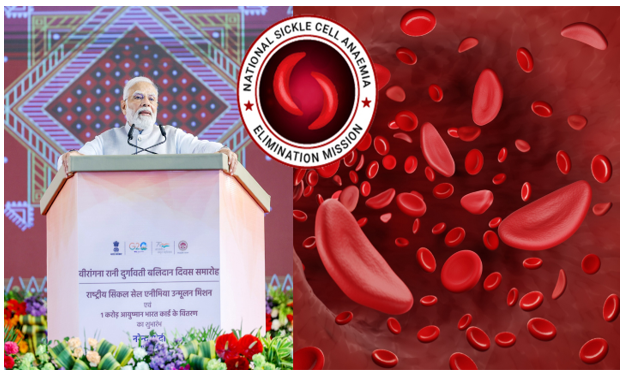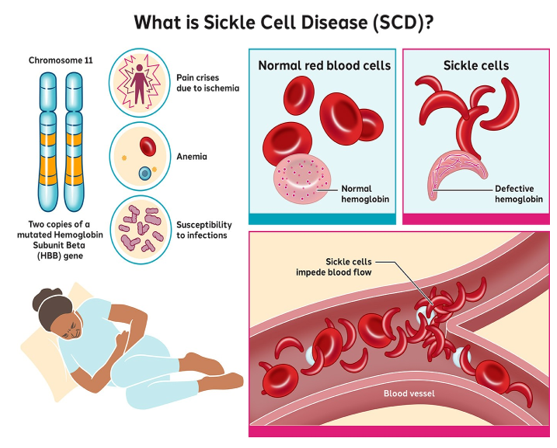- Courses
- GS Full Course 1 Year
- GS Full Course 2 Year
- GS Full Course 3 Year
- GS Full Course Till Selection
- Online Program
- GS Recorded Course
- NCERT (Recorded 500+ Hours)
- Polity Recorded Course
- Geography Recorded Course
- Economy Recorded Course
- AMAC Recorded Course
- Modern India, Post Independence & World History
- Environment Recoded Course
- Governance Recoded Course
- Science & Tech. Recoded Course
- International Relations and Internal Security Recorded Course
- Disaster Management Module Course
- Ethics Recoded Course
- Essay Recoded Course
- Current Affairs Recoded Course
- CSAT
- 5 LAYERED ARJUNA Mentorship
- Public Administration Optional
- ABOUT US
- OUR TOPPERS
- TEST SERIES
- FREE STUDY MATERIAL
- VIDEOS
- CONTACT US
National Sickle Cell Anaemia Elimination Mission
National Sickle Cell Anaemia Elimination Mission
29-06-2023

Latest Context:
Recently, the PM launched the ‘National Sickle Cell Anaemia Elimination Mission’ with the target to eradicate the disease by 2047.
More about the mission:
- The main objective of the mission is to provide affordable and accessible care to all Sickle Cell Disease (SCD) patients.
- Overall vision of the mission is to eliminate SCD as a public health problem in India before the year 2047.
- The mission will be carried out in a mission mode and will focus on 3-pillar strategy:
1. Health promotion: The focus will be on awareness generation & pre-marital genetic counselling.
2. Prevention: Universal screening and early detection will be prioritized.
3. Holistic Management: To eliminate this disease by 2047, focus will be given on holistic management and the research which can increase our understanding regarding this disease.
- Initially, the focus will be on 17 states with higher prevalence of SCD including Gujarat, Maharashtra, Rajasthan, MP, Jharkhand, Chhattisgarh, West Bengal, Karnataka, Assam, UP, Kerala, Bihar, Uttarakhand etc.
What is Sickle Cell Anaemia?
- It’s a genetic blood disorder characterized by the presence of abnormal haemoglobin molecules in red blood cells. Haemoglobin is a protein responsible for carrying oxygen throughout the body.
- Sickle cell anaemia is an inherited disorder, meaning it is passed down from parents to their children. It is more common in individuals of African, Mediterranean, Middle Eastern, and Indian descent. To be born with sickle cell anaemia, a person must inherit the sickle cell gene from both parents.
- In individuals with sickle cell anaemia, a mutation in the gene that codes for haemoglobin causes the production of abnormal haemoglobin known as ‘Haemoglobin S’.
- This abnormal haemoglobin S causes red blood cells to become misshapen and rigid, taking on a crescent or sickle shape instead of the normal round shape. These sickled red blood cells are prone to clumping together, leading to the formation of clots and blockages in the blood vessels. This can cause reduced blood flow to various organs and tissues, resulting in severe pain and damage to organs.
- In India, it is more common in the tribal population but occurs in non-tribals too.

Symptoms are:
- Symptoms of sickle cell anaemia can vary from person to person and can range from mild to severe.
- Some common symptoms include chronic fatigue, pale skin, shortness of breath, delayed growth and development in children, episodes of severe pain known as ‘pain crisis’, increased susceptibility to infections, and organ damage.
About the Treatment
- The treatment for sickle cell anaemia focuses on managing symptoms, preventing complications, and improving quality of life.
- This may involve medications to alleviate pain, prevent infections, or manage complications such as anaemia.
- Regular monitoring, blood transfusions and bone marrow or stem cell transplants may also be part of the treatment plan for some individuals.
Initiatives taken by Indian government to tackle Sickle-Cell Anaemia are:
-
National Sickle Cell Anemia Control Program (NSCAP): The Ministry of Health and Family Welfare launched the NSCAP in 2010. This program aims to prevent and control sickle cell anaemia through early detection, treatment, counselling and awareness programs. It focuses on providing screening services, genetic counselling, and comprehensive healthcare for affected individuals.
-
Screening and Diagnostic Services: The government has established screening programs in regions with a high prevalence of sickle cell anaemia, particularly among tribal populations. These programs involve conducting blood tests to identify individuals with the sickle cell trait or sickle cell anaemia. Early identification helps in providing appropriate medical care and counselling.
-
Treatment and Management: The government has focused on improving access to healthcare services and treatment for individuals with sickle cell anaemia. This includes providing free or subsidized medications such as ‘hydroxyurea’, which can help reduce complications and improve quality of life. Regular monitoring, blood transfusions, and other supportive therapies are also provided to manage the condition effectively.
-
Awareness and Education: The government has conducted awareness campaigns to educate individuals, families, and communities about sickle cell anaemia. These campaigns aim to increase understanding about the condition, its inheritance pattern, the importance of genetic counselling and the available treatment options. Educational materials, workshops, and community outreach programs are used to disseminate information.
-
Capacity Building: The government has focused on building the capacity of healthcare providers to effectively manage sickle cell anaemia. This includes training healthcare professionals on the diagnosis, treatment, and management of the condition. Capacity building efforts also extend to providing specialized care in hospitals and healthcare centers.
-
Research and Collaboration: The Indian government has encouraged research initiatives to better understand sickle cell anaemia and develop improved treatment strategies. Collaboration with national and international organizations, research institutes, and universities has been promoted to advance knowledge and find innovative solutions.
Must Check: IAS Coaching Centre In Delhi

![img-PSYCHOLOGICAL WARFARE [PSYWAR]](https://i.filecdn.in/755esias/PSYCHOLOGICALWARFAREPSYWAR-1747206772505.jpg)

